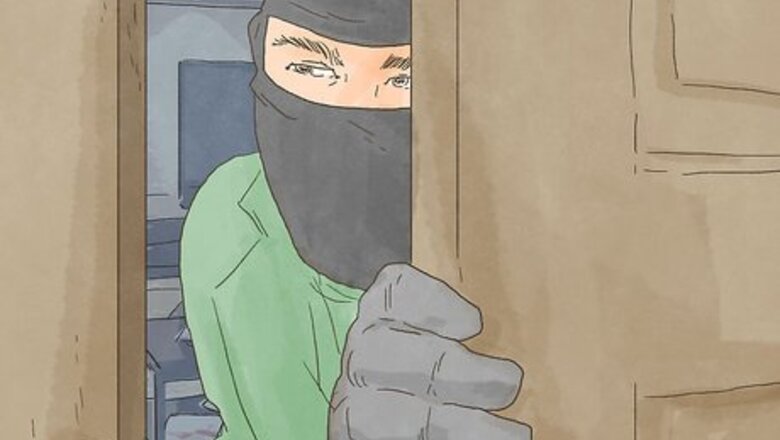
views
Brainstorming Your Story

Use a real life crime or event as inspiration. A good detective story usually starts with a strange or intriguing crime. Look at current news stories for crimes that have been committed recently or solved by real life detectives. Use a crime from the past, such as a cold case that has never been solved, as inspiration for the crime in your story. Look at the crime section in newspapers, true crime shows, and old newspapers at your local library. You can also use a crime that happened to a friend or family member as inspiration for a fictional crime. For example, you may focus on a crime like the murder of a close relative to someone the detective knows or the kidnapping of the most famous police dog in the county.

Come up with a unique detective. The detective in your story is at the center of the mystery so they should be memorable, unique, and smart. They should have character traits like a keen sense of observation and an ability to get information from others. Make the detective in your story brilliant, but also human, with flaws. For example, you may have a detective that is an older woman who appears frail and bumbling, but is in fact a genius at solving crimes. Or you may have a detective who is blind but is able to rely on their other senses to observe their surroundings.

Give the detective a companion or partner. Come up with a secondary character who works with the detective. The companion or partner can give the reader someone to identify with, as the reader may not be able to relate to a genius detective. The companion may not be as smart as the detective, but they can offer perspective on the crime. They can also assist the detective as needed. For example, a famous companion would be Dr. Watson in the Sherlock Holmes mysteries. Dr. Watson acts as a foil to Sherlock Holmes, as he is not as smart but he does help Sherlock to empathize with others and see the crimes in a different light.

Create an engaging plot. A good detective story will have a well-paced plot. A traditional plot outline includes six parts: the set up, the inciting incident, the rising action, the climax, the falling action, and the resolution. An example plot may be: The set up introduces the setting, the main character, and the conflict. For example, start with a detective named Jamie Brains and a murder set in Brains’ hometown. The inciting incident is the event or decision that changes or challenges the main character. For example, Detective Brains may decide to take on the murder case after local detectives cannot solve the murder. The rising action is where you develop your main character and explore their relationship with other characters in the story. For example, Detective Brains may reconnect with an old mentor in her hometown and visiting her childhood home. The climax is the high point of the story, where the main character has to make a major decision or choice. For example, Detective Brains may realize her mentor is the murderer. The falling action is the point where the main character deals with the results of their choice. For example, Detective Brains may have a dramatic shoot out with her mentor as she tries to catch him for the murder. The resolution wraps up the story and tells the reader whether the main character succeeds or fails to achieve their goal. For example, Detective Brains may confront her mentor and find out why he committed the murder. Brains may then leave her hometown, satisfied she solved the crime.

Read examples of detective stories. To get a better sense of the genre, read examples of detective stories in writing anthologies and online. Look for detective stories at your local library and in online mystery magazines. Try to reader newer and older detective stories so you can see how the genre has evolved. Notice how the writer uses suspense, plot, and character to propel the story forward. You may read: "The Murders at the Rue Morgue” by Edgar Allen Poe. "No Place to Park" by Alexander McCall Smith. "My Hobby" by Tom Fabian. And Then There Were None by Agatha Christie. Into the Killer Sphere by Stefania Mattana.
Creating a Draft
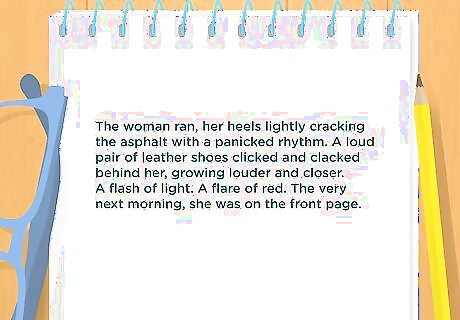
Start with the crime or mystery. Begin by giving your reader a glimpse of the crime or mystery that will be the focus of the story. You may describe the victim and show them just before the crime occurs. Or you may show the detective arriving to the scene of the crime a few hours after it was committed. For example, you may show the detective riding up to the crime on their bike in the early morning. Or you may have the victim running from their attacker and then cut to a scene of the detective discovering their body.
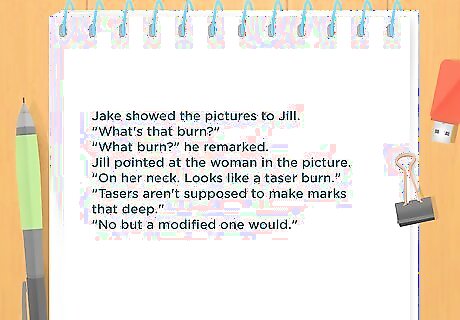
Introduce the key players in the story. Make sure your readers know who the important characters are in the story up front. Include scenes that show the detective and his partner in action as they work to solve the case. Describe the victim as well as any by-standers or secondary characters. For example, you may show the detective paying a visit to her old mentor to signal that the mentor is going to be an important character in the story. You should also introduce characters that could be seen as suspects or perpetrators of the crime so readers can start to feel suspense.
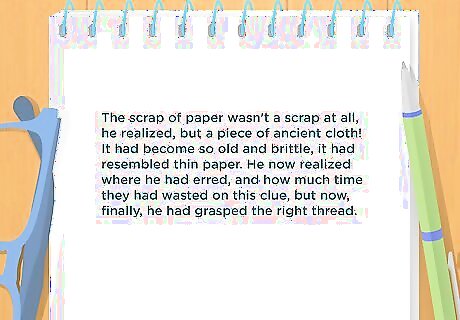
Have clues and red herrings. Clues are essential to a good detective story, as they help to point the detective in the right direction. Clues can be in the form of a witness who remembers a key detail or an object that gives the detective a hunch on a suspect. Make sure your detective story has a trail of clues to keep the suspense and mystery high. You should also include red herrings, which are clues that are false or turn out to be a distraction from the truth. You may use a suspect as a red herring, where the reader thinks one person is guilty when in fact they are innocent. Or you may use an object or a turn of events as a red herring.

Show the detective solving the crime. Include a lot of scenes where the detective starts to piece together the mystery. You may show them tracking down a lead or interviewing witnesses to the crime. You can also show them going through public records or working at the police station. This will help your reader feel like they are part of the process of solving the crime. For example, you may show the detective and her partner pouring through case files to find out if there were any similar crimes in the past. After a long night of too much caffeine and no sleep, the detective may stumble on a case file that contains a few clues.
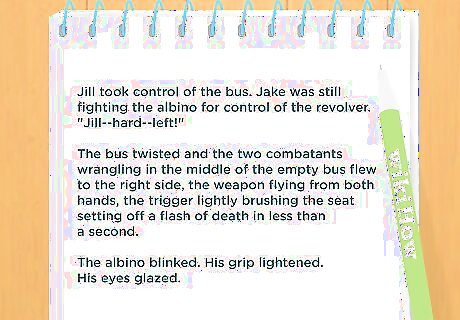
Include scenes with physical action. Make your reader sit on the edge of their seat by including scenes where the detective has to be physical. Have physical action that helps to build the plot and add to the suspense. Do not just include physical action for the sake of it. Make it count. For example, the detective may get wrapped up in a car chase with a suspect or go on a foot chase to follow a lead in the case. Or maybe they have to break into someone’s home or go on a stake out where they observe a suspect. For example, you may have a scene where the detective goes on a foot chase through the woods to catch her mentor, who has become her number one suspect.
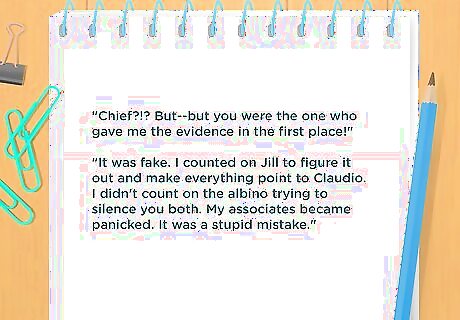
Have a plot twist. Most good detective stories will have at least one plot twist, where the reader has their assumptions flipped around. The plot twist usually occurs towards the end of the story. Sometimes, the ending of the story is the plot twist, surprising the reader in a satisfying way. Make sure the plot twist does not feel too obvious or gimmicky to the reader. The plot twist should feel shocking to the reader, but they should also be able to trace back and see how you built up to the twist. For example, you may have a plot twist where the detective realizes her mentor lied to her about her parents’ death. Her mentor’s lie may cause the detective, and the reader, to question her entire relationship with her mentor.
Revising the Draft

Read the story aloud. Once you have finished a draft of the story, read it aloud to yourself. Listen to how the language sounds. Make sure each scene feels important to the overall plot. Check that your characters come across as unique and memorable in the story, especially the detective. You can also read the story aloud to help catch any spelling, grammar, or punctuation errors.

Show the story to others. Get friends, family, and peers to read the detective story. Ask them if they found the story suspenseful and exciting. Find out if they thought the detective was an interesting character who was a credible problem solver. You can also ask if they found the plot twist surprising and effective in the story. Be open to constructive criticism from others and apply their feedback to make your story better.

Revise the story for length. Once you have received feedback from others, revise the story line by line. Make sure the detective story stays short and does not go on for too many pages. Most short stories run between 1,000-7,500 words. Try to keep your detective story within this word count so it stays short.

Adjust the story for clarity. Check that the story is easy to read and follow from beginning to end. Make sure there are no awkward moments or unclear lines in the story. Reading the story aloud after you have revised it can help you check it for clarity.
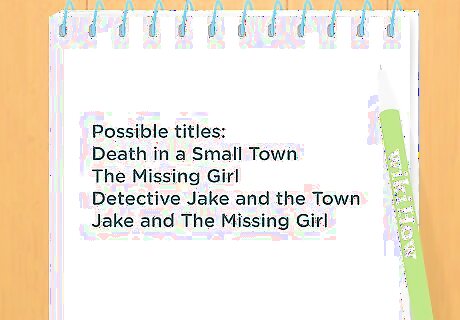
Title the story. As part of the revision process, you can also title the story. Pick a title that will give the readers a sense of the mystery or crime. You can also use the detective as inspiration for the title. For example, you may choose a title like “Death in a Small Town” or “The Missing Girl.” Titles like "Detective Brains and the Town" or "Brains and The Missing Girl" would also work.




















Comments
0 comment